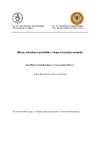Identificador persistente para citar o vincular este elemento:
https://accedacris.ulpgc.es/jspui/handle/10553/1568
| Campo DC | Valor | idioma |
|---|---|---|
| dc.contributor.author | Oreja Rodríguez, Juan Ramón | en_US |
| dc.contributor.author | Yanes Estévez, Vanessa | en_US |
| dc.date.accessioned | 2009-10-08T02:31:00Z | - |
| dc.date.accessioned | 2018-06-06T09:05:30Z | - |
| dc.date.available | 2018-06-06T09:05:30Z | - |
| dc.date.issued | 2004 | en_US |
| dc.identifier.other | 1993 | - |
| dc.identifier.uri | https://accedacris.ulpgc.es/handle/10553/1568 | - |
| dc.description.abstract | El concepto de riesgo es uno de los criterios y conceptos más considerados en la toma de decisiones estratégicas. Tras adoptar la perspectiva del comportamiento, surgen diversos estudios y modelos que pretenden contribuir a su mejor entendimiento en dirección de empresas. En este trabajo, aportamos algunas evidencias sobre variables que también deberían ser consideradas en dichos modelos. Utilizamos una muestra de empresas que desarrollan sus actividades en un entorno geográficamente diferenciado como es Las Islas Canarias (España). A partir de la identificación de diversas dimensiones dentro del concepto de riesgo, comprobamos que lo que se percibe o entiende por riesgo estratégico condiciona el riesgo que finalmente se asume. De esta forma seguimos ahondando en los procesos mentales de los decisores al enfrentarse a la toma de decisiones. Base de lo que debería ser la nueva ciencia del management (Simon, 1977). | en_US |
| dc.description.abstract | “Risk” is one of the most used criterion and concepts in decision making. After following the behavioural perspective, some studies and models were published. All of them to clarify the concept in business administration. In this paper we try to make some contributions about other variables that should be also considered in those models. To reach that objective, we used a sample of firms in a geographically differentiated environment, Canary Islands. From the identification of some dimensions of the construct, we contrasted that what individuals perceived as strategic risk conditioned the amount of assumed risk. In this way, we contribute to know more about the mental processes of manager while making decision. The base of what should be the new science of management (Simon, 1977). | en_US |
| dc.language | spa | en_US |
| dc.source | Documentos de Trabajo Conjuntos ULPGC-ULL, 2005-04 | en_US |
| dc.subject | 5311 Organización y dirección de empresas | en_US |
| dc.subject.other | Análisis | en_US |
| dc.subject.other | Riesgo estratégico | en_US |
| dc.subject.other | Strategic risk | en_US |
| dc.subject.other | Decision making | en_US |
| dc.subject.other | Comportamientos | en_US |
| dc.subject.other | Empresas | en_US |
| dc.subject.other | Finanzas | en_US |
| dc.subject.other | Gestión | en_US |
| dc.subject.other | Canarias | en_US |
| dc.title | Riesgo estratégico percibido y riesgo estratégico asumido | en_US |
| dc.type | info:eu-repo/semantics/book | en_US |
| dc.type | Book | en_US |
| dc.identifier.absysnet | 509460 | - |
| dc.investigacion | Ciencias Sociales y Jurídicas | en_US |
| dc.rights.accessrights | info:eu-repo/semantics/openAccess | es |
| dc.type2 | Libro | en_US |
| dc.utils.revision | Sí | en_US |
| dc.contributor.wosstandard | Yanes Estévez, Vanessa | - |
| dc.identifier.ulpgc | Sí | en_US |
| item.fulltext | Con texto completo | - |
| item.grantfulltext | open | - |
| Colección: | Libro | |
Los elementos en ULPGC accedaCRIS están protegidos por derechos de autor con todos los derechos reservados, a menos que se indique lo contrario.
